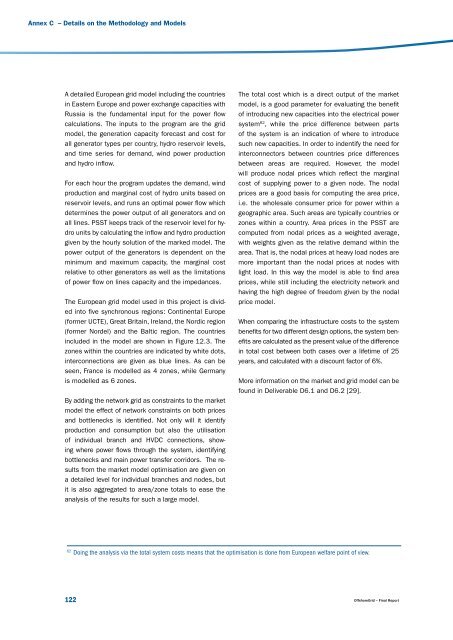Offshore Electricity Infrastructure in Europe - European Wind Energy ...
Offshore Electricity Infrastructure in Europe - European Wind Energy ...
Offshore Electricity Infrastructure in Europe - European Wind Energy ...
Create successful ePaper yourself
Turn your PDF publications into a flip-book with our unique Google optimized e-Paper software.
Annex c – details on the Methodology and Models<br />
A detailed <strong>Europe</strong>an grid model <strong>in</strong>clud<strong>in</strong>g the countries<br />
<strong>in</strong> Eastern <strong>Europe</strong> and power exchange capacities with<br />
Russia is the fundamental <strong>in</strong>put for the power flow<br />
calculations. The <strong>in</strong>puts to the program are the grid<br />
model, the generation capacity forecast and cost for<br />
all generator types per country, hydro reservoir levels,<br />
and time series for demand, w<strong>in</strong>d power production<br />
and hydro <strong>in</strong>flow.<br />
For each hour the program updates the demand, w<strong>in</strong>d<br />
production and marg<strong>in</strong>al cost of hydro units based on<br />
reservoir levels, and runs an optimal power flow which<br />
determ<strong>in</strong>es the power output of all generators and on<br />
all l<strong>in</strong>es. PSST keeps track of the reservoir level for hydro<br />
units by calculat<strong>in</strong>g the <strong>in</strong>flow and hydro production<br />
given by the hourly solution of the marked model. The<br />
power output of the generators is dependent on the<br />
m<strong>in</strong>imum and maximum capacity, the marg<strong>in</strong>al cost<br />
relative to other generators as well as the limitations<br />
of power flow on l<strong>in</strong>es capacity and the impedances.<br />
The <strong>Europe</strong>an grid model used <strong>in</strong> this project is divided<br />
<strong>in</strong>to five synchronous regions: Cont<strong>in</strong>ental <strong>Europe</strong><br />
(former UCTE), Great Brita<strong>in</strong>, Ireland, the Nordic region<br />
(former Nordel) and the Baltic region. The countries<br />
<strong>in</strong>cluded <strong>in</strong> the model are shown <strong>in</strong> Figure 12.3. The<br />
zones with<strong>in</strong> the countries are <strong>in</strong>dicated by white dots,<br />
<strong>in</strong>terconnections are given as blue l<strong>in</strong>es. As can be<br />
seen, France is modelled as 4 zones, while Germany<br />
is modelled as 6 zones.<br />
By add<strong>in</strong>g the network grid as constra<strong>in</strong>ts to the market<br />
model the effect of network constra<strong>in</strong>ts on both prices<br />
and bottlenecks is identified. Not only will it identify<br />
production and consumption but also the utilisation<br />
of <strong>in</strong>dividual branch and HVDC connections, show<strong>in</strong>g<br />
where power flows through the system, identify<strong>in</strong>g<br />
bottlenecks and ma<strong>in</strong> power transfer corridors. The results<br />
from the market model optimisation are given on<br />
a detailed level for <strong>in</strong>dividual branches and nodes, but<br />
it is also aggregated to area/zone totals to ease the<br />
analysis of the results for such a large model.<br />
The total cost which is a direct output of the market<br />
model, is a good parameter for evaluat<strong>in</strong>g the benefit<br />
of <strong>in</strong>troduc<strong>in</strong>g new capacities <strong>in</strong>to the electrical power<br />
system 62 , while the price difference between parts<br />
of the system is an <strong>in</strong>dication of where to <strong>in</strong>troduce<br />
such new capacities. In order to <strong>in</strong>dentify the need for<br />
<strong>in</strong>terconnectors between countries price differences<br />
between areas are required. However, the model<br />
will produce nodal prices which reflect the marg<strong>in</strong>al<br />
cost of supply<strong>in</strong>g power to a given node. The nodal<br />
prices are a good basis for comput<strong>in</strong>g the area price,<br />
i.e. the wholesale consumer price for power with<strong>in</strong> a<br />
geographic area. Such areas are typically countries or<br />
zones with<strong>in</strong> a country. Area prices <strong>in</strong> the PSST are<br />
computed from nodal prices as a weighted average,<br />
with weights given as the relative demand with<strong>in</strong> the<br />
area. That is, the nodal prices at heavy load nodes are<br />
more important than the nodal prices at nodes with<br />
light load. In this way the model is able to f<strong>in</strong>d area<br />
prices, while still <strong>in</strong>clud<strong>in</strong>g the electricity network and<br />
hav<strong>in</strong>g the high degree of freedom given by the nodal<br />
price model.<br />
When compar<strong>in</strong>g the <strong>in</strong>frastructure costs to the system<br />
benefits for two different design options, the system benefits<br />
are calculated as the present value of the difference<br />
<strong>in</strong> total cost between both cases over a lifetime of 25<br />
years, and calculated with a discount factor of 6%.<br />
More <strong>in</strong>formation on the market and grid model can be<br />
found <strong>in</strong> Deliverable D6.1 and D6.2 [29].<br />
62 Do<strong>in</strong>g the analysis via the total system costs means that the optimisation is done from <strong>Europe</strong>an welfare po<strong>in</strong>t of view.<br />
122 <strong>Offshore</strong>Grid – F<strong>in</strong>al Report









